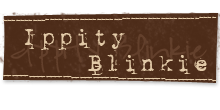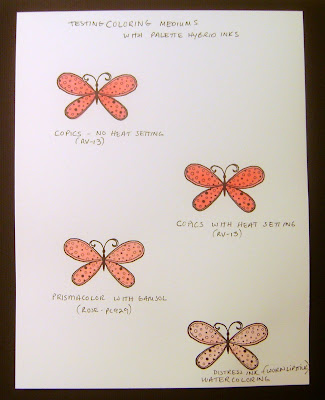Hi there!! It is Kelly here and it is my turn to share today's That's How post with you except rather than giving you a That's How tutorial, I am going to give you a That's What lesson instead! And the What I am going to talk about today are Hybrid Inks!
Hybrid Inks are the type of inks that are sold by {ippity} chicks. After reading about them if you decide you need some then you can contact your {ippity} chick to purchase some! If you need an {ippity} chick, use the chick locator tab on the left side bar to find one near you!
Ink Primer 101
What exactly are Hybrid Inks?
{Ippity} stamps began carrying Palette Hybrid inks with the release of their stamps in November 2009. There are a total of 36 hybrid ink colors made and those carried by {ippity} are increasing on a regular basis.
So what are hybrid inks?
Given some recent discussions on the {ippity} forums, I felt it was time to answer that question!
Hybrid is a term that has received much press in recent years. It is defined by Wikipedia as “the combination of two or more different things, aimed at achieving a particular objective or goal. We have all heard of hybrid cars and their unique ability to combine the power of a combustion type engine with the fuel economy of an
electric engine to make an engine that is better for our environment while decreasing gas consumption. In the case of inks, Palette hybrid inks (according to their manufacturer, Stewart Superior), are designed to take the guesswork out of deciding which type of ink to use for what stamping project because they work for nearly all stamping techniques.
For starters, let’s take a look at the different types of inks that are available to stampers.
Dye inks- come in water-based or water proof styles. They can be used to stamp on multiple types of paper. They dry quickly as they soak in and stain the fibers of the paper. Typically they are acidfree but may fade over time and can run when exposed to water or water based coloring mediums (unless waterproof.) (Examples: Water based: SU Classic Ink Pads, Memento; Waterproof: Memories, Archival.)
Pigment inks- this type of ink is thicker than water based inks. They are designed to dry on the surface instead of soak into the fibers and are therefore slower drying. The end result is usually a brighter color when compared to dye inks. They work well for embossing, but must be heat set when used on glossy paper and may not dry at all. (Examples: SU Craft Ink pads, Brilliance, Versamagic.)
Solvent based inks- inks that are opaque and can be used on any surface including smooth and glossy surfaces. They are considered permanent when dry and may have an accompanying odor. Despite cleaning with a special solution, they may stain the surface of your stamps. The pads tend to dry out faster than other types of inks. (Example: Staz-On.)
Hybrid inks- this type of ink blends the best attributes of both dye and pigment inks. It is non-solvent yet dries instantly on porous surfaces and papers. It requires heat setting for use on glossy surfaces and fabrics. It is acid-free and archival; it doesn’t fade and is waterproof. It has been known to bleed when used with alcohol based inks like Copic markers unless heat set before use.
Using hybrid inks has been new for me, so I decided to do some comparisons with other inks that I have had some more experience with.
Comparing the Brilliance of Inks
The first thing I tested was how brightly the ink stamped onto white paper. I compared four black inks that I had in my stash. I stamped Palette Noir Hybrid ink, Versamagic Midnight Black Pigment ink, Archival Ink Jet Black Dye ink and Memento Tuxedo Black Dye ink.
My pigment ink pad may have been on the dry side, but it definitely did not stamp as brilliantly as the dye based of Palette hybrid ink. But at a glance I was as satisfied with the way the Palette Noir ink stamped in comparison to my Memento ink which is the ink I use most often when stamping line images to color.
Comparing Palette Hybrid ink with Different Coloring Mediums
Next I wanted to test how different coloring mediums affected the Palette Noir ink. I stamped the Palette Noir ink onto Paper Trey Ink’s 120 lb paper and assessed whether the ink ran or not, and if it needed heat setting or not. I colored the stamped images with Copics, Prismacolors and Distress Ink.
Copics without Heat setting:
I noticed a small amount of blurring of the ink. I determined that if I did further blending,
the black ink would likely have bled even more.
Copics with Heat Setting:
No blurring of the ink lines occurred after heat setting the image for a few seconds.
Prismacolor Pencils with Gamsol:
The ink did not run when coloring the image with Prismacolor Pencils using Gamsol to blend it.
Distress inks diluted with water:
Again, no blurring of the inked lines occurred even after adding distressed ink diluted with water.
Comparing some Palette ink colors with Stampin’ Up colors
The final comparison I wanted to make was see how the Palette Hybrid ink colors that I have compare with the Stampin Up colors that I have.
I couldn’t compare the blacks since I do not own any black Stampin Up inks. The SU inks I own are the Classic inks which are a form of Dye based inks. The Burnt Umber was a close match to SU’s Close to Cocoa. The Viridian Leaf green was a bit brighter, but still very similar to SU’s Garden Green. One of Palette Hybrids red shades Moulin Rouge was a bit deeper in hue to SU’s Ruby Red.
Palette Hybrid Ink Colors
Currently there are 36 colors of Palette Hybrid inks made by Stewart Superior. You can see all the colors offered in the chart below.
Five colors are available for purchase by {ippity} chicks from the {ippity} site, but new colors are being added on a regular basis.
My Final Thoughts
In my opinion (and it is only that,) after comparing the various inks that I have shown here, I am comfortable in suggesting that Palette Hybrid inks could replace most of the stamp pads that you are currently using. They stamp onto white paper with the same brilliance that many dye based inks do and they are even safe to use with most coloring mediums. I do suggest using heat setting if you choose to use them with Copic markers. They are safe for use with your cards and scrapbooks because they are acid-free and archival. They are fast drying and fade proof and have no odor.
If you haven’t tried Palette Hybrid inks I suggest that you do and do your own comparison. You may find that you could clean out some extra space in your stamp room by replacing many of your currently used stamp pads with these inks that can serve many purposes!!
I would love to hear some of your experiences with using Hybrid inks. Feel free to share them with us in the comments section below!
























thanks, kelly for the great info! i use palette inks and really like them, (except for when i use copics, i like the memento) i'll try the heat setting on the palettes!
ReplyDeleteKelly, what an awesome post and so much of information. I really appreciate you taking time to put this together for us. WOW.
ReplyDeleteGreat post.....thanks for taking the time to explain these inks. You've answered all the questions I had and I look forward to getting some soon.
ReplyDeleteKelly, this is one amazing tutorial...so much detail and so love the samples. Thank you for taking the time and sharing all this knowledge with us!
ReplyDeleteThanks for the "That's What.." info about these inks. This was a well thought out and well written post on the subject of Palette Inks.
ReplyDeleteGreat comparison! Thanks for taking the time to share and answer a lot questions!
ReplyDeleteThis was great info and I really appreciate it! When I received my hybrid ink, I though, oh, well, another ink pad. I understand so much more than I had before!
ReplyDeleteThank you Kelly! I know this was a lot of work and I really appreciate it. I know sometimes I am so confused as to which ink to use and this does explain so nicely each.
ReplyDeleteI have even started a little folder on inks and their differences to help me, so this info will go in it as well.
Thanks again!
Hi, thanks for the breakdown on inks! This article was helpful for a newbie like me to understand the different inks. I had a question, is using Gamsol to blend color pencils an acid free and archival method?
ReplyDeleteKelly, This post was SUPER helpful! Thank you for taking the time to make it and do all the comparisons.
ReplyDelete